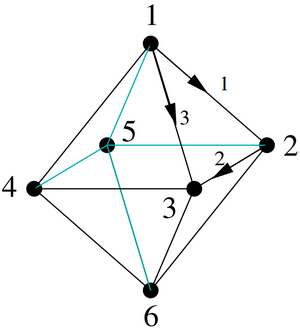Science:Math Exam Resources/Courses/MATH307/April 2012/Question 04 (c)
{{#incat:MER QGQ flag|{{#incat:MER QGH flag|{{#incat:MER QGS flag|}}}}}}
• Q1 (a) • Q1 (b) • Q1 (c) • Q1 (d) • Q2 (a) • Q2 (b) • Q2 (c) • Q3 • Q4 (a) • Q4 (b) • Q4 (c) • Q4 (d) • Q4 (e) • Q5 (a) • Q5 (b) • Q5 (c) • Q6 (a) • Q6 (b) • Q6 (c) • Q6 (d) • Q7 (a) • Q7 (b) • Q7 (c) • Q8 (a) • Q8 (b) • Q8 (c) •
Question 04 (c) |
|---|
|
Consider a network arranged in the shape of an octahedron as in this diagram: The nodes have been labeled with the large numbers and 3 of the edges (resistors) have been given orientations and labeled with small numbers. Assume all resistances are equal to 1. Let D be the incidence matrix (for some choice of labeling and arrows for the remaining edges) and let L be the Laplacian. (c) Is is true that N(D) = N(L)? Give a reason. |
|
Make sure you understand the problem fully: What is the question asking you to do? Are there specific conditions or constraints that you should take note of? How will you know if your answer is correct from your work only? Can you rephrase the question in your own words in a way that makes sense to you? |
|
If you are stuck, check the hint below. Consider it for a while. Does it give you a new idea on how to approach the problem? If so, try it! |
Hint |
|---|
|
Science:Math Exam Resources/Courses/MATH307/April 2012/Question 04 (c)/Hint 1 |
|
Checking a solution serves two purposes: helping you if, after having used the hint, you still are stuck on the problem; or if you have solved the problem and would like to check your work.
|
Solution |
|---|
|
Yes, it is true that the nullspace of the incidence matrix (D) is equal to the nullspace of the Laplacian matrix. The reason for this is that the Laplacian matrix represents the total current flowing into or out of a node: According to Kirchoff’s Current Law, current flowing into a node must equal to the current flowing out of the node, there cannot be a buildup of current at any node if there are no batteries attached, which there isn’t in this question. This can be expressed as: For this to be true, because current flow has to be 0. For current flow to be equal to 0, you would have to have a voltage difference of 0, meaning that the voltage at each node is exactly the same, Therefore: |
{{#incat:MER CT flag||
}}





